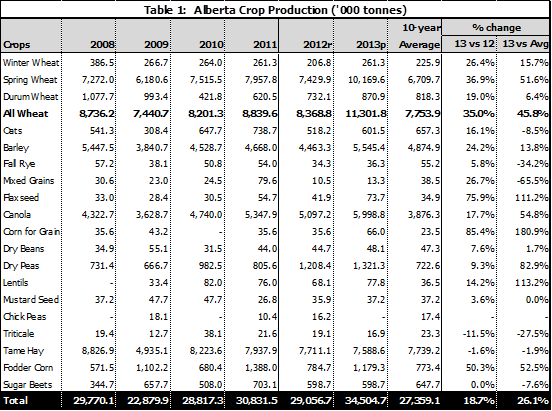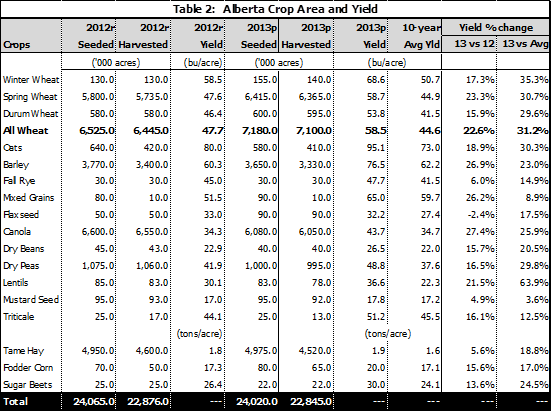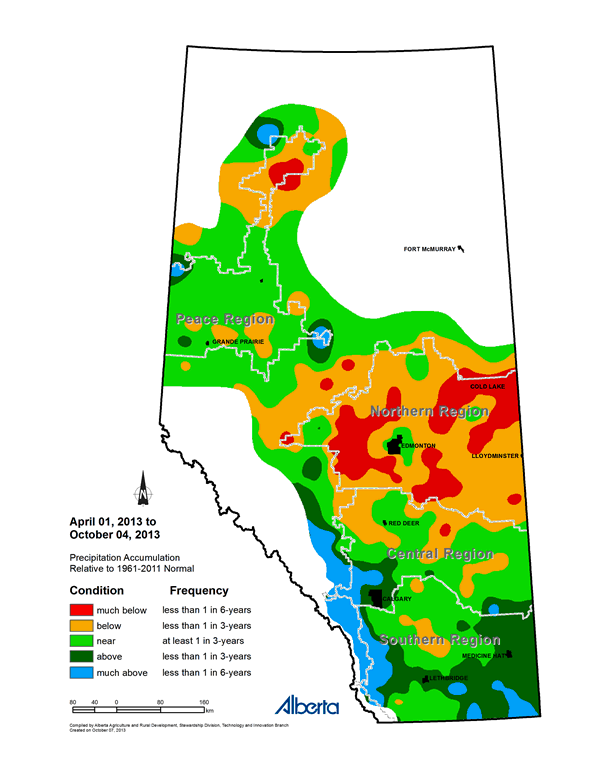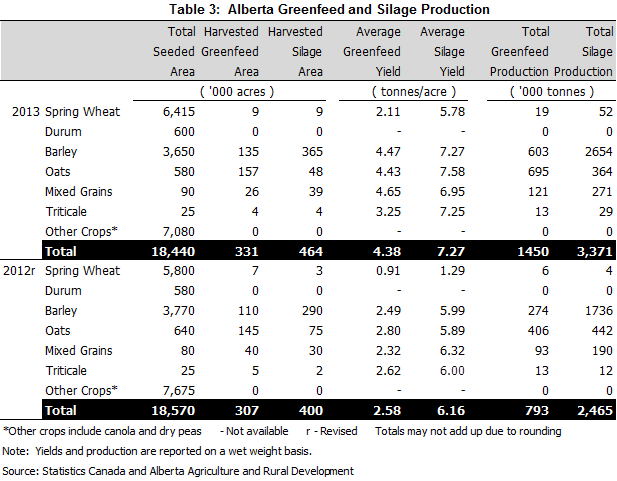| | The 2013 crop season | Insects and crop diseases | Forage and pasture | Alberta crop production, 2013 | Alberta forage production, 2013 | Alberta crop production tables | Precipitation map
,
Overview
This report presents a review of the crop season and an analysis of crop production statistics for 2013. In addition, a precipitation map for the 2013 crop season is attached for reference.
The 2013 Crop Season
Crop growing conditions in the province during 2013 were very favourable. Producers started seeding later than normal given a wet, cool spring, but the remainder of the season was warm with frequent precipitation. These conditions provided producers with the opportunity for a record harvest, with above average crop quality and yields. Provincial average yields were from 10 per cent to 30 per cent above their respective 10-year averages.
Seeding was delayed by cool spring temperatures and several snow storms. The resulting slow snow melt delayed soil dry down and warming. Surface soil moisture ratings in the province were high throughout the spring, benefiting from several precipitations. Excessive moisture was a problem in the North East, North West and Peace Regions. Standing water was also reported in some regions. At the end of May, the province experienced warm, windy conditions, which when coupled with a lack of rainfall, depleted the surface soil moisture in some areas. Provincial seeding progress, as of May 21, 2013, was estimated as 66 per cent complete. This was on par with the 10-year average.
In June, rain brought moisture to all areas of the province during the first two weeks. Soil moisture reserves at the surface level were excellent for seed germination. Despite cool temperatures earlier in the spring, producers were able to complete seeding by early June. However, by mid-June, crop development was mostly delayed due to cool and wet weather. Surface soil moisture conditions were reported at 87 per cent good to excellent as of June 18.
Precipitation and warm temperatures across all regions in the province significantly advanced crop development in early July. Provincial crop condition ratings were very favourable, with 88 per cent of crops rated in good to excellent conditions as of July 16, 2013. For the reminder of July, weather patterns shifted to cooler and drier, but frequent rain showers continued to delay haying operations, lowering quality especially across the northern half of the province. Surface soil moisture conditions remained practically unchanged from June.
In August, the mix of warm and wet weather continued to benefit crop development. Soil moisture conditions remained good to excellent in most areas of the province. Spraying for bertha armyworm on canola was reported in some areas. By the end of August, the patch of warm weather was ideal for harvest to start. Harvest progress was most advanced in southern and central Alberta. Provincially, three per cent of crops were harvested as of August 27.
In September, most of the province experienced excellent weather that advanced crop maturity and allowed harvest to progress. Producers started to report higher yields, estimated to be above their 10-year averages, and of good quality. Despite some precipitation in the South and Peace Regions (which slowed down harvest), it was estimated that 71 per cent of the crops were in the bin as of September 24, which was 23 per cent ahead of the five-year average.
By middle October, harvest was virtually completed due to the warm and dry weather. Overall, crop yields in the province in 2013 were 10 to 30 per cent above their 10-year averages. In terms of crop quality, grade estimates for both cereals and oilseeds were above average, mainly as a result of the warm and wet weather throughout the summer, and dry harvesting conditions in the fall. However, there were reports in some areas of ergot contamination on wheat, oats, barley and triticale, due to the cool and wet conditions in early spring.
Insects and Crop Diseases
In 2013, crop damage from pest infestations was less severe compared to the previous year. The most noticeable damage was from bertha armyworms, wheat midge, lygus bugs and grasshoppers. Bertha armyworm was a concern in southern and central Alberta, as well as in the Peace Region. Wheat midge caused some damage in the Peace Region. Lygus bugs were a less severe problem compared to 2012, with the South Region of the province being the most problematic area. There were some problems with grasshoppers infestation in 2013 especially in some parts of the Peace Region.
Damp weather conditions in spring and early summer contributed to crop diseases in many areas in the fall especially for sclerotinia and clubroot. Some incidents of sclerotinia were reported throughout the province, and were common in many crops including canola, dry beans, sunflower and pea. Specifically, sclerotinia appeared mainly in northern Alberta due to the wet weather, and in south part of the province later in the season. Spread of clubroot also caused some damage mainly in the Central, North East and North West Regions, while Northern Alberta remained disease free.
Forage and Pasture
In May, pasture had a good start across the province, due to adequate moisture conditions, especially in the Peace and Central Regions. Provincially, May pasture conditions were reported as three per cent poor, 21 per cent fair, 50 per cent good, and 26 per cent excellent. Throughout the summer, pasture ratings remained mostly unchanged around 80 per cent as good to excellent. By September, the ratings decreased to 65 per cent as good to excellent, due to drier and warmer weather and lack of precipitation.
With respect to tame hay, production was down from 2012, due to a smaller harvested area, despite yields being up. The high yields were mainly as a result of favourable moisture reserves throughout the spring and summer. There was some delay in haying operations across the province, due to the cool, wet spring and rainy summer. While hay yields were above their 10-year averages, quality was average to below average, since much of the first cut hay was either rained on, or cut late resulting in over maturity.
Alberta Crop Production, 2013
Total 2013 crop production increased in Alberta
On December 4, 2013, Statistics Canada released its third and final report for 2013 entitled "Production of Principal Field Crops, November 2013". Based on this report, total 2013 production of principal field crops in Alberta was estimated at a record 34.5 million tonnes, 18.7 per cent higher than in 2012, and 26.1 per cent above the 10-year average for 2003-2012 (see Table 1). The higher production mostly stemmed from record yields for nearly all crops. Provincial average yields were above their respective 10-year averages (see Table 2). Crop growing conditions in the province during 2013 were very favourable. Seeding was later than normal given a cool and wet spring, but the reminder of the season was hot, with frequent precipitation. These conditions provided producers the opportunity to make good harvest, reporting crops of above average crop quality. Total seeded and harvested areas of principal field crops in the province fell marginally by 0.2 per cent and 0.1 per cent, respectively.
Production by crop type, Alberta
Total production of spring wheat in 2013, increased 36.9 per cent from 2012, to a record of 10.2 million tonnes, and was 51.6 per cent above the ten-year average of 6.7 million tonnes. The record production stemmed from a record yield and an increase in seeded and harvested areas. Harvested area increased to 6.4 million acres, up 11.0 per cent from 2012. Yield jumped 23.3 per cent to 58.7 bushels per acre, and was 30.7 per cent above the 10-year average. Total durum production increased 19.0 per cent over 2012, to 870,900 tonnes. The higher production was due to harvested area increasing 2.6 per cent to 595,000 acres, and a record average yield of 53.8 bushels per acre (up 15.9 per cent). Overall, total production of all wheat reached a record 11.3 million tonnes, an increase of 35.0 per cent from 2012.
Total barley production was up 24.2 per cent over 2012, to 5.5 million tonnes. The rise in production was due to a record average yield which more than offset the lower harvested and seeded areas. With an average provincial yield of 76.5 bushels per acre, this was 26.9 per cent above 2012, and 23.0 per cent above the 10-year average.
Total canola production was a record at 6.0 million tonnes, up 17.7 per cent from 2012. Driving the increase were higher yields, as both seeded and harvested areas declined. The provincial average yield was a record 43.7 bushels per acre, up 27.4 per cent from 2012, and 25.9 per cent above the 10-year average.
Production of dry peas set a second consecutive record at 1.3 million tonnes, and up 9.3 per cent from 2012. This was driven by a record yield of 48.8 bushels per acre (up 16.5 per cent from 2012), which more than offset declines in seeded and harvested areas.
Total oats production increased 16.1 per cent, to 601,500 tonnes, and was attributed to a record average yield, which more than offset lower harvested and seeded areas. The average yield in 2013 was 95.1 bushels per acre, up 18.9 per cent from last year, and 30.3 per cent above the 10-year average.
2013 crop production, Canada
Based on the November estimates, total 2013 Canadian production was 27.2 million tonnes for spring wheat, 6.5 million tonnes for durum, 10.2 million tonnes for barley, 3.9 million tonnes for oats, 18.0 million tonnes for canola, and 3.9 million tonnes for dry peas.
Alberta Forage Production, 2013
Total tame hay production in Alberta in 2013 was estimated at 7.59 million tonnes, based on the Statistics Canada report “Production of Principal Field Crops, November, 2013”. This was down 1.6 per cent from 2012, and 1.9 per cent below the 10-year average. The lower production was as a result of a smaller harvested area, despite the high yields (1.9 tons per acre).
Based on a survey conducted by the Statistics and Data Development Branch of Alberta Agriculture and Rural Development, total greenfeed production in the province increased 83 per cent from 2012, to 1.5 million tonnes (Table 3). The higher production was attributed to a marked increase in yields and higher harvested area. For silage, total production was estimated at 3.4 million tonnes, up 36.8 per cent from 2012, due to higher yields and harvested area.
The mainly favourable crop growing conditions in 2013 contributed significantly to higher yields than in 2012. The provincial average yield for greenfeed was estimated at 4.38 tonnes per acre. This was 69.8 per cent above 2012. For silage, the provincial average yield was estimated at 7.3 tonnes per acre, up 17.9 per cent from 2012.
Producers reported a higher total harvested area for greenfeed, which was up 7.8 per cent from 2012, to 331,000 acres. Silage acreage also increased 16.0 per cent, to 464,000 acres. Barley and oats were the major crops harvested for greenfeed and silage production, although significant acreages of mixed grains, and some spring wheat and triticale were also taken off as forages.
Contacts
For additional information relating to this report, please do not hesitate to contact the subject area specialist.
Alberta Agriculture and Rural Development
Economics and Competitiveness Division
Statistics and Data Development Branch
Lukas Matejovsky
Crop Statistician
780-422-2887
Email: lukas.matejovsky@gov.ab.ca |
Alberta Crop Production Tables


Note: Totals may not add up due to rounding. 10-year average refers to 2003 to 2012.
Source: Statistics Canada p-preliminary r-Revised - Not available. -- Not applicable. bu - Bushels Avg - Average Yld - Yield
Prepared by: Alberta Agriculture and Rural Development, Economics and Competitiveness Division, Statistics and Data Development Branch.
Precipitation Map for the 2013 Crop Season

Source: Alberta Agriculture and Rural Development, Environmental Stewardship Division, Technology and Innovation Branch
 |
|